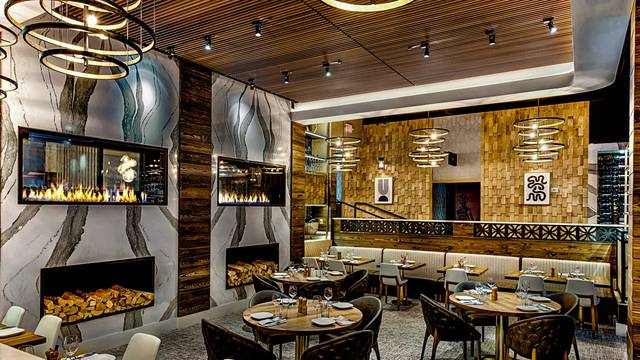Pan Asian Restaurant Islamabad: Discover Exquisite Asian Food
Pan Asian Restaurant Islamabad: Discover Exquisite Asian Food
Blog Article
Savor Authentic Eastern Cuisine With a Pan-Asian Spin for a Cooking Experience
Starting a culinary journey through authentic Eastern cuisine, boosted with a Pan-Asian spin, uses an one-of-a-kind chance to check out the rich tapestry of flavors that define the region's varied culinary traditions. This experience welcomes you to enjoy the beautiful equilibrium of tastes-- wonderful, salted, spicy, and sour-- harmonized by aromatic natural herbs and flavors. Envision the innovative fusion of Thai curry and ramen or the unanticipated pleasure of sushi burritos. As you contemplate these luring meals, think about the cultural stories and historical influences that shape them, each bite supplying a tale waiting to be found.

Exploring Pan-Asian Flavors
In the realm of global gastronomy, Pan-Asian cuisine sticks out for its exceptional diversity and the unified interaction of tastes from numerous Asian societies. This cooking approach commemorates the distinct active ingredients and rich practices located across the continent, developing a tapestry of preferences that is both rewarding and intriguing. Secret to Pan-Asian cuisine is its capacity to balance contrasting tastes-- wonderful, salty, spicy, and sour-- while highlighting the freshness and top quality of each component.
From the umami-rich soy sauce of Japan to the fiery chili peppers of Thailand, Pan-Asian cuisine uses an extensive combination of flavors. These components are often combined in creative means, improving dishes with layers of complexity. As an example, the usage of aromatic natural herbs such as lemongrass and cilantro, typical in Vietnamese and Thai food, adds a revitalizing illumination to recipes, while the unification of coconut milk provides a velvety, rich structure.
The emphasis on fresh fruit and vegetables and fragrant spices makes sure that each meal is not only a banquet for the taste buds but also for the detects. Pan-Asian food welcomes diners to start a cooking journey, discovering the huge and varied landscapes of Asian gastronomy with every bite.
Fusion Recipes to Try
While Pan-Asian cuisine is celebrated for its conventional tastes, the modern cooking landscape is significantly welcoming combination recipes that mix these classic aspects with impacts from other regions. This cutting-edge strategy not only honors the abundant heritage of Asian cookeries however also introduces novel taste experiences that interest contemporary tastes.
A prime example of such a blend dish is the Korean-Mexican taco, where seasoned bulgogi beef is covered in a cozy tortilla, covered with kimchi and a spicy gochujang-infused salsa. This mix weds the bold, savory flavors of Korea with the dynamic, fresh elements of Mexican cuisine. Similarly, sushi burritos have acquired popularity, integrating the fragile virtuosity of Japanese sushi with the passionate, hand-held ease of a burrito, typically including fusion active ingredients like tempura shrimp and avocado with a drizzle of wasabi mayo.
Another notable recipe is Thai curry ramen, which infuses the creamy, aromatic spices of Thai curry into the soothing broth of typical Japanese ramen, creating a harmonious mix that entices the senses. These blend meals prolong beyond mere uniqueness; they stand for a culinary dialogue between societies, encouraging expedition and development worldwide of Pan-Asian food.
Necessary Ingredients and Spices
To truly appreciate Pan-Asian food, one need to recognize the crucial active ingredients and seasonings that develop its structure. This varied cooking design attracts from an abundant tapestry of Eastern practices, employing a harmonious mix of flavors and textures. Secret components include soy sauce, fish sauce, and oyster sauce, which pass on a mouthwatering umami depth necessary to Oriental dishes. Complementary to these are rice vinegar and mirin, lending a Fine dining experience Islamabad delicate level of acidity and sweetness.
Fragrant components are crucial, with garlic, ginger, and lemongrass being common throughout different Pan-Asian dishes. These components provide an aromatic base that boosts the complexity of tastes. Seasonings such as star anise, cardamom, and cinnamon introduce heat and character, echoing influences from regions like China and India.

Cooking Methods and Tips
Grasping the art of Pan-Asian cuisine requires knowledge with its distinct food preparation methods, each adding to the lively tapestry of flavors this cooking practice is celebrated for. Central to these approaches is the stir-fry, a rapid cooking strategy that protects the nutritional stability and vibrant colors of ingredients. Utilizing a wok, the stir-fry approach permits for also warm distribution, important for achieving the characteristic appearance and taste balance of Pan-Asian dishes.
Another basic method is steaming, especially prevalent in Chinese food. This mild method keeps the all-natural flavors and nutrients of ingredients, making it suitable for seafood and vegetables. Dumplings, a precious staple, commonly benefit from steaming, leading to soft, delicious structures.
Cooking, likewise important, gives smoky midsts to dishes such as Oriental bulgogi or Japanese yakitori (Fine dining experience Islamabad). This strategy often entails marinating active ingredients, permitting flavors to pass through deeply before food preparation over an open flame or warm plate
Lastly, understanding the art of balancing flavors-- pleasant, sour, salty, bitter, and umami-- is critical. Correctly layering these components can elevate a meal from ordinary to amazing, supplying a complicated and pleasing cooking experience that embodies the significance of Pan-Asian food.
Dining Experiences Worldwide
Around the world, Pan-Asian food provides an unparalleled dining experience, commemorated for its abundant tapestry of flavors and dynamic discussions. This cooking phenomenon has gone beyond social boundaries, catching the hearts and tastes of food enthusiasts worldwide. In multicultural cities fresh York, London, and Sydney, Pan-Asian dining establishments serve as fusions where cooking traditions from Thailand, Japan, China, and beyond assemble, giving diners with an eclectic mix of meals that highlight the area's variety.
The worldwide charm of Pan-Asian cuisine depends on its ability to provide both credibility and innovation. Cooks skillfully marry conventional ingredients such as lemongrass, soy sauce, and miso with contemporary techniques, resulting in recipes that are both refreshingly brand-new and familiar. This blend enables diners to start a cooking trip that appreciates heritage while accepting modernity.
Additionally, dining experiences are elevated via attentively developed environments that mirror the principles of Pan-Asian aesthetics. From minimal Japanese-inspired interiors to vibrant Thai-themed rooms, each restaurant offers an one-of-a-kind atmosphere that complements the cooking offerings. Therefore, patrons are not just taking in a meal yet partaking in a cultural experience, making Pan-Asian eating a genuinely global sensation.
Conclusion
The expedition of Pan-Asian cuisine supplies a profound understanding of the detailed interplay of tastes and culinary practices across Asia. By welcoming fusion recipes such as Thai curry ramen and sushi burritos, the culinary trip not only highlights the versatility of conventional active ingredients but additionally showcases innovative modern-day techniques. This gastronomic experience, improved by necessary spices and cooking techniques, provides a distinct possibility to value the multiculturalism and cooking artistry that specify Pan-Asian food on an international range.
Beginning on a cooking trip through genuine Oriental food, boosted with a Pan-Asian spin, supplies an one-of-a-kind possibility to explore the rich tapestry of tastes that define the region's varied culinary traditions.In the world of worldwide gastronomy, Pan-Asian cuisine stands out for its impressive variety and the harmonious interaction of tastes from various Eastern cultures. Secret to Pan-Asian food is its ability to balance contrasting tastes-- wonderful, salty, spicy, and sour-- while highlighting the quality and high quality of each component.

Report this page